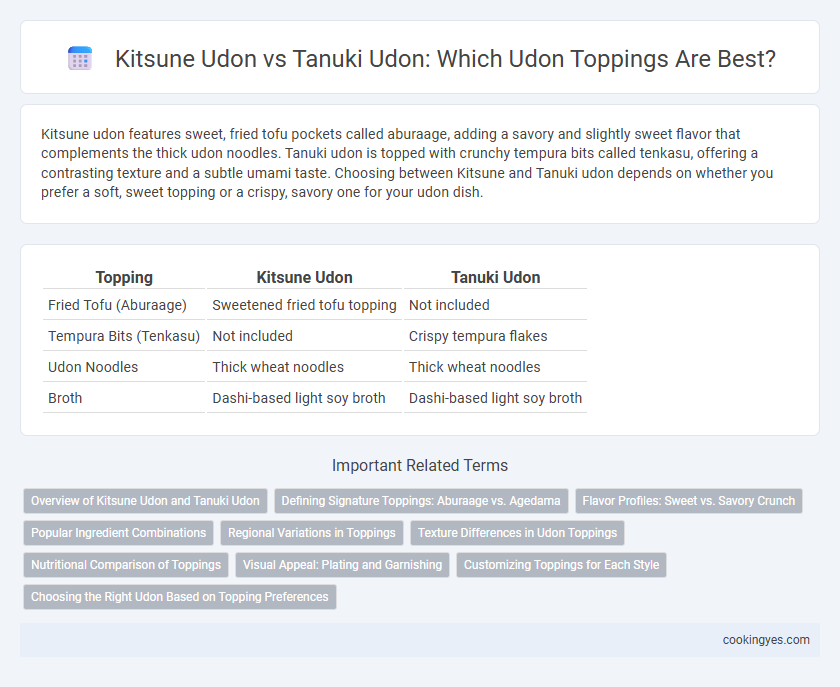Kitsune udon features sweet, fried tofu pockets called aburaage, adding a savory and slightly sweet flavor that complements the thick udon noodles. Tanuki udon is topped with crunchy tempura bits called tenkasu, offering a contrasting texture and a subtle umami taste. Choosing between Kitsune and Tanuki udon depends on whether you prefer a soft, sweet topping or a crispy, savory one for your udon dish.
Table of Comparison
| Topping | Kitsune Udon | Tanuki Udon |
|---|---|---|
| Fried Tofu (Aburaage) | Sweetened fried tofu topping | Not included |
| Tempura Bits (Tenkasu) | Not included | Crispy tempura flakes |
| Udon Noodles | Thick wheat noodles | Thick wheat noodles |
| Broth | Dashi-based light soy broth | Dashi-based light soy broth |
Overview of Kitsune Udon and Tanuki Udon
Kitsune Udon features thick udon noodles topped with sweet, tender aburaage (fried tofu), offering a subtly sweet and savory flavor profile. Tanuki Udon includes crunchy, crispy tenkasu (tempura scraps) as its main topping, adding a rich texture and umami punch to the broth. Both dishes showcase traditional Japanese udon varieties, highlighting distinct topping choices that define their unique taste experiences.
Defining Signature Toppings: Aburaage vs. Agedama
Kitsune udon features aburaage, sweetened deep-fried tofu pockets that provide a rich, savory flavor and slightly chewy texture, defining its signature topping. Tanuki udon is topped with agedama, crispy tempura bits that add a crunchy contrast to the soft noodles and broth. These distinct toppings create unique taste profiles, with aburaage emphasizing subtle sweetness and agedama delivering a satisfying crunch.
Flavor Profiles: Sweet vs. Savory Crunch
Kitsune udon features sweet, tender aburaage (fried tofu pouch) that imparts a subtly sweet and rich flavor, complementing the soft udon noodles and savory broth. Tanuki udon is topped with crunchy tenkasu (tempura batter bits), adding a savory, crispy texture that contrasts with the smooth noodles and enhances the umami depth of the dish. The choice between Kitsune udon and Tanuki udon primarily hinges on preference for sweet versus savory crunch in topping flavor profiles.
Popular Ingredient Combinations
Kitsune udon features sweet, seasoned aburaage (fried tofu) as its signature topping, bringing a rich umami flavor and chewy texture that complements the thick udon noodles. Tanuki udon is topped with crispy tenkasu (tempura batter crumbs), adding a light crunch and subtle savory taste that contrasts well with the smooth broth. Both variations highlight popular ingredient combinations that enhance the traditional udon experience through distinct textures and flavors.
Regional Variations in Toppings
Kitsune udon features sweetened aburaage (fried tofu) as its distinctive topping, popular primarily in the Kansai region, reflecting the area's preference for light, subtly sweet flavors. Tanuki udon is topped with tenkasu (crispy tempura bits), favored in eastern Japan, especially the Kanto region, where robust, savory tastes dominate. These regional variations in udon toppings highlight the diverse culinary traditions across Japan, emphasizing local ingredient availability and flavor profiles.
Texture Differences in Udon Toppings
Kitsune udon features sweet, chewy aburaage (fried tofu) that adds a silky, slightly spongy texture complementing the thick, smooth udon noodles. Tanuki udon is topped with crunchy tenkasu (tempura flakes), providing a light, crispy contrast that gradually softens in the broth, enhancing the overall mouthfeel. The texture differences between the dense, rich aburaage and the airy, crisp tenkasu create distinct sensory experiences for each udon variety.
Nutritional Comparison of Toppings
Kitsune udon features aburaage, or fried tofu pouch, which is rich in protein and healthy fats, providing a source of plant-based nutrition and moderate calories. Tanuki udon is topped with tenkasu, crunchy tempura batter bits that add a higher fat content and more carbohydrates but fewer proteins compared to aburaage. Choosing between the two depends on whether one prioritizes protein and satiety from aburaage or a lighter, crisp texture with extra carbohydrates from tenkasu.
Visual Appeal: Plating and Garnishing
Kitsune udon features golden-brown, thinly fried tofu slices (aburaage) artfully placed atop the noodles, creating a warm, inviting visual contrast with the clear broth. Tanuki udon is distinguished by a generous sprinkle of tenkasu (crispy tempura bits), adding texture and a dynamic, rustic garnish that enhances the bowl's visual complexity. Both toppings emphasize different aesthetic qualities: Kitsune udon's smooth, uniform shape offers elegance while Tanuki udon's irregular, crunchy pieces provide a lively, eye-catching finish.
Customizing Toppings for Each Style
Kitsune udon features aburaage, sweet fried tofu, as its primary topping, offering a rich, savory flavor and slightly chewy texture that enhances the simple broth. Tanuki udon is topped with tenkasu, crunchy tempura bits, which add a crispy texture and lighter, more varied taste profile to the dish. Customizing toppings for each style allows for balancing textures and flavors, with Kitsune udon favoring sweetness and smoothness, while Tanuki udon emphasizes crispiness and contrast.
Choosing the Right Udon Based on Topping Preferences
Kitsune udon features sweetened aburaage (fried tofu) as its topping, offering a mild, slightly sweet flavor that complements the savory broth, ideal for those who enjoy delicate, plant-based toppings. Tanuki udon is topped with tenkasu (crispy tempura flakes), providing a crunchy texture and rich umami taste that enhances the noodle's overall heartiness. Selecting between Kitsune and Tanuki udon depends on whether you prefer a soft, sweet topping or a crispy, savory addition to your udon experience.
Kitsune udon vs Tanuki udon for toppings Infographic

 cookingyes.com
cookingyes.com